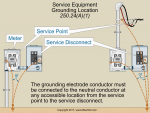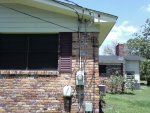JasonCo
Senior Member
- Location
- Houston, Texas
I feel like I'm constantly in a war with inspectors wanting different things, it's frustrating. I'm just wondering what the truth is so help me God! In a metered disconnect, I know code wants you to bond neutral to the equipment, but would you send your GEC down to Earth as this point also, or would you do it at your service disconnect? POCO + Inspector doesn't want anything at all going on inside the meter, so that's out of question where I'm at. Just wondering if there is a code that sets things straight for doing this at a metered disconnect instead of at the service disconnect.
I personally feel like the service disconnect is where the GEC should be, along with the start of your EGC. Last inspector I had red tagged me for this, but what the heck? So inspectors don't want it in the meter because it isn't accessible, yet POCO also locks the metered disconnect... This inspector I keep getting holds his chest way too high. I think 250.24 goes into this a bit... The way I read it, it can be in either one?
I personally feel like the service disconnect is where the GEC should be, along with the start of your EGC. Last inspector I had red tagged me for this, but what the heck? So inspectors don't want it in the meter because it isn't accessible, yet POCO also locks the metered disconnect... This inspector I keep getting holds his chest way too high. I think 250.24 goes into this a bit... The way I read it, it can be in either one?
Last edited:


 . Actually, that is kind of an interesting academic question: whether the laws in a given area grant the inspector authority to enforce POCO requirements. I could see some areas not stating it.
. Actually, that is kind of an interesting academic question: whether the laws in a given area grant the inspector authority to enforce POCO requirements. I could see some areas not stating it.


